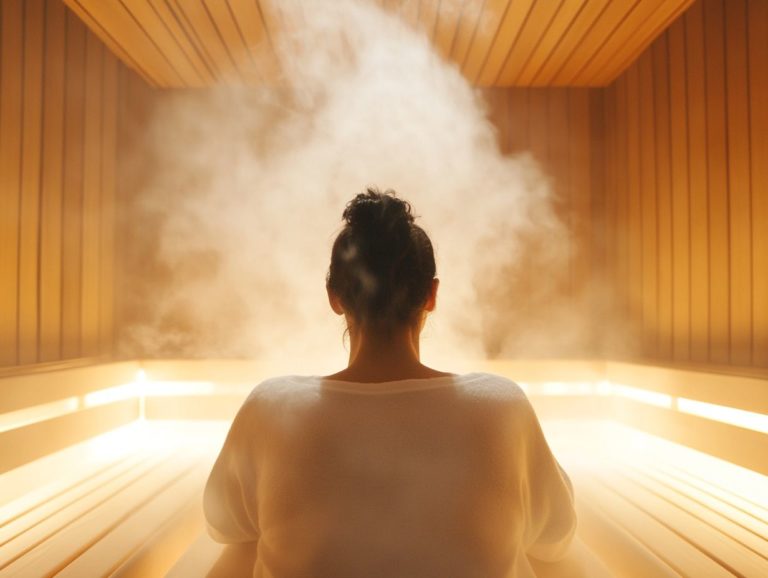Saunas: Key to a Healthier Lifestyle
Saunas boast a rich history that spans centuries, transforming into a cherished wellness ritual embraced worldwide.
This article invites you to explore the various types of saunas, from traditional to infrared models. You ll uncover the numerous health benefits. Sauna sessions have been linked to improved cardiovascular health and enhanced mental well-being. You will learn important safety tips to ensure a rejuvenating experience.
Discover how to seamlessly weave regular sauna sessions into your lifestyle for optimal health.
Dive in and unlock the amazing benefits of saunas!
Contents
- Key Takeaways:
- The History of Saunas
- Types of Saunas
- Health Benefits of Saunas
- How to Use a Sauna Safely
- Incorporating Saunas into Your Lifestyle
- Frequently Asked Questions
- What is a sauna and how does it contribute to a healthier lifestyle?
- What are the different types of saunas available, including traditional Finnish saunas?
- Are saunas safe for everyone to use, or are there specific sauna risks?
- How often should I use a sauna to experience the health benefits and enhance my wellness routine?
- Can I use a sauna if I have a cold or flu, or should I wait due to potential dehydration risks?
- What are some tips for safely using a sauna to ensure hydration and well-being?
Key Takeaways:

- Regular use of saunas can improve both physical and mental well-being, making it an essential component of a healthy lifestyle.
- Traditional and infrared saunas, which are revered for their authentic experience, offer different benefits, so it’s important to choose the type that best suits your needs and preferences.
- Incorporating saunas into your wellness routine supports overall health and vitality while ensuring safety through proper precautions.
The History of Saunas
The sauna is an ancient custom that continues to provide numerous health benefits, primarily traced back to Finland. For thousands of years, these steam-filled sanctuaries have served as a refuge for relaxation, socialization, and health maintenance.
In Finnish culture, sauna bathing is an ancient custom revered for its relaxation and health benefits. It s not just a therapeutic practice; it s a cherished communal space where families and friends come together to bond and rejuvenate.
Origins and Evolution of Saunas
Saunas trace their roots back to ancient customs, particularly in Finland. Sauna bathing began as a straightforward yet effective way to enhance relaxation and promote health through the soothing power of using heat to help relax muscles and relieve stress.
The earliest saunas were humble abodes, often dug into the earth or constructed from logs. They were meticulously designed to retain warmth while offering a sanctuary from the harsh northern climate. Over the centuries, this Finnish tradition flourished, spreading throughout Europe and weaving in influences from various cultures.
Today, you can choose from modern variations like traditional wood-burning saunas, which are revered for their authentic experience, or infrared saunas, which utilize cutting-edge technology to deliver heat more efficiently and penetrate the skin at a deeper level.
Saunas have evolved far beyond their historical roots, becoming essential components of contemporary wellness routines that prioritize overall health, stress relief, and social connection, underscoring their lasting cultural significance in global health practices.
Types of Saunas
You ll find a delightful variety of saunas available today, such as traditional Finnish saunas, infrared saunas, and steam saunas, each offering unique experiences that enhance relaxation and respiratory health.
Each type presents its own unique benefits and experiences, catering to the preferences of every sauna enthusiast.
Traditional vs. Infrared Saunas

The debate surrounding traditional Finnish saunas and infrared saunas revolves around their distinct methods of heat delivery and the unique health benefits each offers.
Traditional Finnish saunas harness heated stones to create a high-temperature, humid environment, while infrared saunas utilize infrared panels that warm your body directly without significantly elevating the air temperature. This variation in heating methods means that traditional saunas typically achieve temperatures ranging from 150 F to 195 F, whereas infrared saunas operate at a more moderate range, often between 120 F and 140 F.
As a result, you might find that a session in a traditional sauna leads to a more intense sweating experience, potentially enhancing detoxification and health maintenance. On the other hand, an infrared sauna provides a comfortable experience that promotes relaxation, improves circulation, and may even offer pain relief. Understanding these differences is essential for anyone exploring which sauna type aligns best with their wellness aspirations.
Health Benefits of Saunas
The health benefits of saunas are extensive and impressive, encompassing improved heart health, effective detoxification, enhanced mental well-being, and accelerated muscle recovery after workouts.
Incorporating sauna sessions into your wellness routine can be a transformative choice, elevating both your physical and mental well-being to new heights.
Physical and Mental Benefits
Sauna sessions offer a wealth of physical and mental benefits, such as improved heart health, enhanced muscle recovery, and a delightful boost in endorphin production that can elevate your relaxation and mental well-being.
These heat-driven retreats work wonders by stimulating your circulation, significantly aiding recovery from sore muscles after an intense workout. By promoting better blood flow, they ensure that oxygen and nutrients reach damaged tissues more effectively, speeding up the healing process.
Regular sauna use can help combat heart disease, as exposure to heat has been shown to improve heart rate variability and enhance overall cardiovascular function. Sauna relaxation eases stress and boosts feel-good hormones, fostering a positive mental state and a profound sense of tranquility that many find deeply rewarding.
How to Use a Sauna Safely
To enjoy the full benefits of sauna bathing, understanding safety is essential. This includes maintaining proper hydration and mastering effective temperature control during your sessions. Being aware of potential risks associated with sauna use can significantly improve your overall wellness routine.
Precautions and Tips

When you step into a sauna, taking specific precautions is key to ensuring a safe and enjoyable experience. Staying hydrated and being mindful of potential risks can make all the difference.
Hydration is your best friend in the heat, so make it a priority to drink water before you enter and during your breaks. Aim to keep your sauna sessions to about 15-20 minutes; this sweet spot allows your body to enjoy the benefits without feeling overwhelmed.
Pay close attention to the sauna’s temperature, ideally between 150 and 195 degrees Fahrenheit. Always listen to your body if you start to feel any discomfort, don t hesitate to step out for a cool-down.
By following these practical strategies, you can effectively maintain your health and enhance your overall sauna experience, turning it into a truly rejuvenating ritual.
Experience the invigorating benefits of sauna sessions by booking one today!
Incorporating Saunas into Your Lifestyle
Incorporating sauna sessions into your lifestyle can truly elevate your wellness routine, offering you a sanctuary for relaxation, effective stress management, and an array of health benefits.
Frequency and Duration of Use
Determining the right frequency and duration for your sauna sessions is crucial for maximizing health benefits while minimizing any potential risks associated with sauna use.
To achieve optimal results, it’s important to consider your health conditions and goals. For most healthy adults, using a sauna two to three times per week is effective, with each session lasting between 15 to 30 minutes. This can yield significant cardiovascular and muscular benefits.
Research indicates that regular sauna exposure can enhance circulation, assist with detoxification which means removing toxins from the body and even foster relaxation. Always pay attention to how your body feels; adjusting the frequency and duration based on your personal tolerance and hydration levels can significantly enhance your overall experience.
If you have any pre-existing health concerns, consult your healthcare provider before embarking on a sauna regimen.
Combining with Other Wellness Practices
Combining sauna therapy with other wellness practices can elevate your overall health benefits, effectively supporting stress management and achieving your goals. This combined approach lets you experience deeper relaxation and rejuvenation.
Integrating meditation before or after your sauna sessions can enhance mental clarity and emotional balance, fostering a holistic sense of well-being.
Engaging in light exercises, such as yoga or stretching, while basking in the sauna heat can boost your flexibility and circulation, amplifying those physical benefits even further.
Alternating sauna use with a cold shower can invigorate your body’s endocrine or hormone and immune systems, offering a refreshing contrast that energizes and revitalizes you.
By embracing these practices, you not only improve your physical health but also cultivate a more mindful and centered lifestyle.
Frequently Asked Questions

What is a sauna and how does it contribute to a healthier lifestyle?
A sauna is a small room or space that is heated to high temperatures, typically using a wood or electric stove. The heat and steam produced by the sauna have been shown to have numerous health benefits, such as improving circulation, detoxifying the body, and promoting relaxation and stress relief.
What are the different types of saunas available, including traditional Finnish saunas?
There are several types of saunas available, including traditional wood-burning saunas, electric saunas, infrared saunas, and steam saunas. Each type uses a different method of heating, but all offer similar health benefits, such as improved cardiovascular health and relaxation.
Are saunas safe for everyone to use, or are there specific sauna risks?
Saunas are generally safe for most healthy individuals to use. However, pregnant women, people with heart conditions, and those who are sensitive to high temperatures should consult with their doctor before using a sauna.
How often should I use a sauna to experience the health benefits and enhance my wellness routine?
The frequency of sauna use depends on individual preferences and health goals. Some people choose to use sauna sessions daily to enhance relaxation and stress management, while others may use it several times a week. It is important to listen to your body and not overdo it, as spending too much time in a sauna can lead to dehydration and other adverse effects.
Can I use a sauna if I have a cold or flu, or should I wait due to potential dehydration risks?
It is generally not recommended to use a sauna when you have a cold or flu, as the high temperatures and steam can worsen symptoms and potentially spread the illness to others. Engaging in sauna therapy while ill may increase dehydration risk. It is best to wait until you have fully recovered before using a sauna again.
What are some tips for safely using a sauna to ensure hydration and well-being?
To enjoy your sauna experience, staying hydrated is essential. Drink plenty of water before, during, and after your session to avoid dehydration. Don’t underestimate hydration; it s crucial for your safety and enjoyment!
Limit your time in the sauna to 10-15 minutes and take breaks to cool down. Always follow the manufacturer’s instructions for safe use, and never use a sauna alone.






